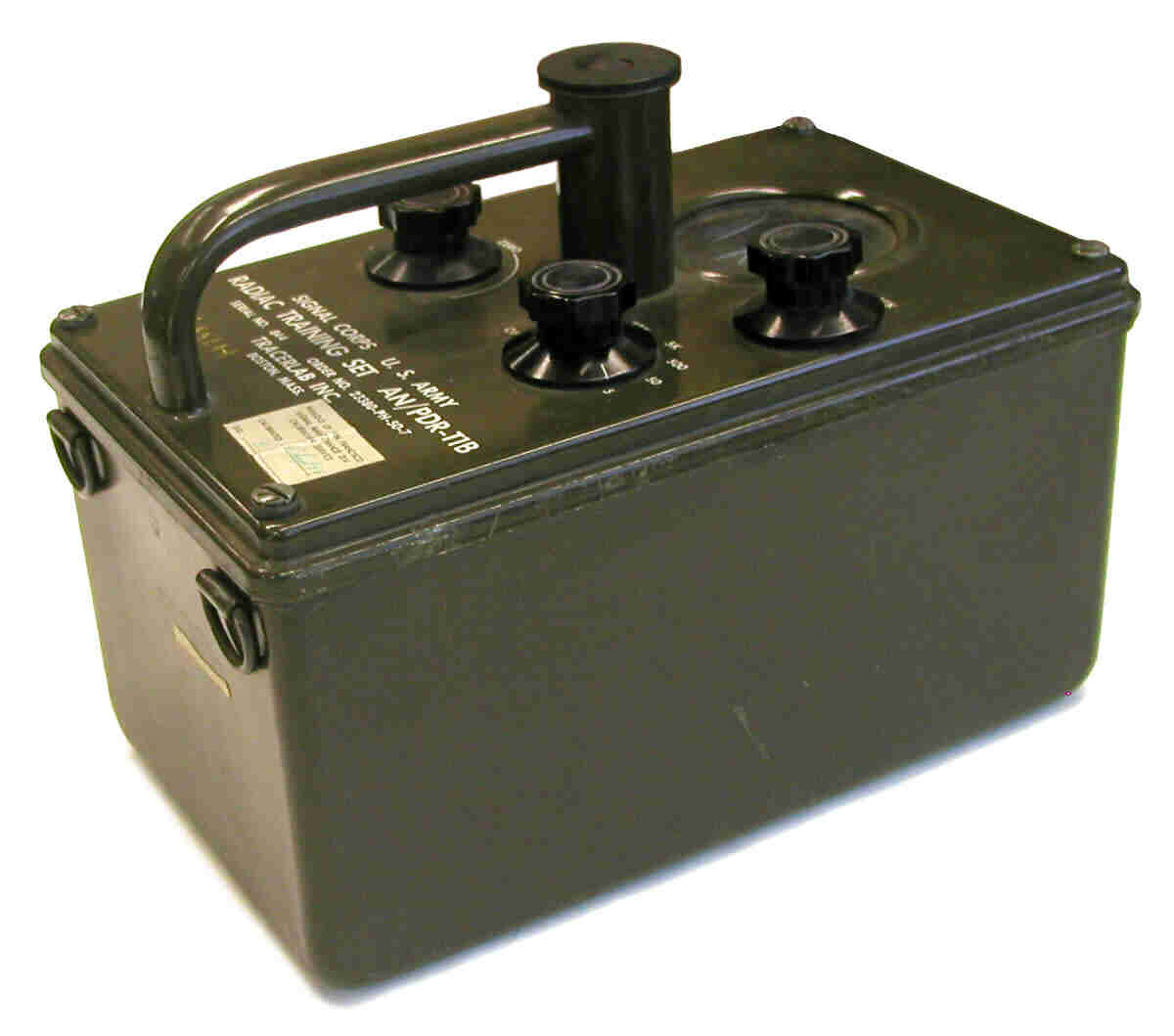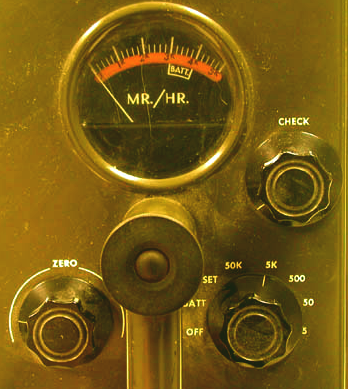AN/PDR-T1B Survey Meter for Training (ca. 1955)

Radiological Defense, Vol. IV (ca. 1950/51) states that the "AN/PDR-T-1 is the first ionization chamber gamma survey meter to be built to military specifications. These specifications were evolved from the Sandstone operational tests of commercial instruments such as the 247A (IM-3/PD) and the MX-6 (IM-40/PD). The AN/PDR-T-1 is thoroughly ruggedized and will operate under any weather conditions of temperature and humidity in which the batteries will operate. The chamber is so constructed that it will operate in aircraft to an elevation of at least 35,000 feet."
The AN/PDR-T1, T1A and T1B are described in the Directory of Radiac Equipment (page date, 1957) as “ionization chamber instruments used to detect the presence of gamma-emitting radioactive materials and to train operators in the use and maintenance of this type of equipment.” The T1B differs slightly from the two earlier versions (T1 and T1A) in that it has a built-in beta check source (activated by the control knob just to the right of the meter face) and a circular faced meter. No mention of any of the three models is made in the 1966 version of the List of Military and Civil Defense Radiac Devices suggesting that they were obsolete by then.
The calibration date on this particular instrument is September 1958.

The ionization chamber, located inside the case, was box-shaped and had polystyrene walls that were made conductive with an aquadag coating on the inside. The walls served as the anode while a central wire bent into a rectangular shape served as the cathode. The chamber was air-filled and 54 cubic inches in volume.
The most distinctive feature of the AN/PDR-T1B is its method for changing scales. The switch for changing the scales was connected (by a chain much like that used on a bicycle) to a wheel underneath the meter face on which the different scale ranges were indicated. Each range was indicated in a unique color. When the range switch was turned, the wheel to which it was connected also turned. This caused the range seen on the meter face to change.
The T1B had five selectable scales: 0-5 (green), 0-50 (white), 0-500 (yellow), 0-5,000 (orange), and 0–50,000 mR/h (magenta). The meter face could be illuminated by a light that was activated by the circular black button on the tip of the handle.
The T1 ion chamber seems to have been first produced in 1949. Quoting an article in the October 13, 1949 issue of the Berkshire Evening Eagle: ""Radiac sets" a new type of radiation detecting and measuring device suitable for both military and civilian defense use, are now in production, the Army has announced. Army Signal Corps prepared specifications for the new device, first instrument of its kind, according to the Army. Designed specifically for rugged field use. Its base is the physicist's ionization chamber... Deliberately made less sensitive than the Geiger Counter, the radiac set is for detection and measurement of relatively large concentrations of radiation beyond capabilities of the Geiger counter, such as would result from an atomic bomb blast. Its immediate use is primarily for training troops as radiation survey teams which would, in the event of an atom blast, go over the blasted area to determine when and where it would be safe for human beings to venture and how long they could remain safely." This, description, if accurate, would seem to indicate that radiation survey teams were excluded by the Army from what we normally think of as humanity.
Range: 0-5.0, 0-5.00, 0-500, 0-5,000, and 0-50,000 mR/h
Size: 6.2” x 8” x 10.4”
Weight: Models T1 and T1A, 10 pounds; Model T1B, 11 pounds
Batteries:
- Model T1 - One 1.3 volt, one 1.5 volt, one 5.2 volt, one 22.5 volt, one 45 volt, one 180 volt
- Model T1A - One 1.3 volt, two 1.5 volt, one 45 volt, two 67.5 volt
- Model T1B - One 1.3 volt, one 1.5 volt, one 45 volt, two 67.5 volt
Manufacturers: Model T1 and T1A, Kelley-Koett; Model T1B, Tracerlab.
Donated by Ron Kathren.
References
- Campbell, D.C., Radiological Defense, Vol. IV Armed Forces Special Weapons Project, Foreward dated January 1950.
- Directory of Radiac Equipment NAVSHIPS 94200.5, no date, ca. 1961-62.
- Defense Atomic Support Agency, List of Military and Civil Defense Radiac Devices. DASA 1243 revised, 1966.
